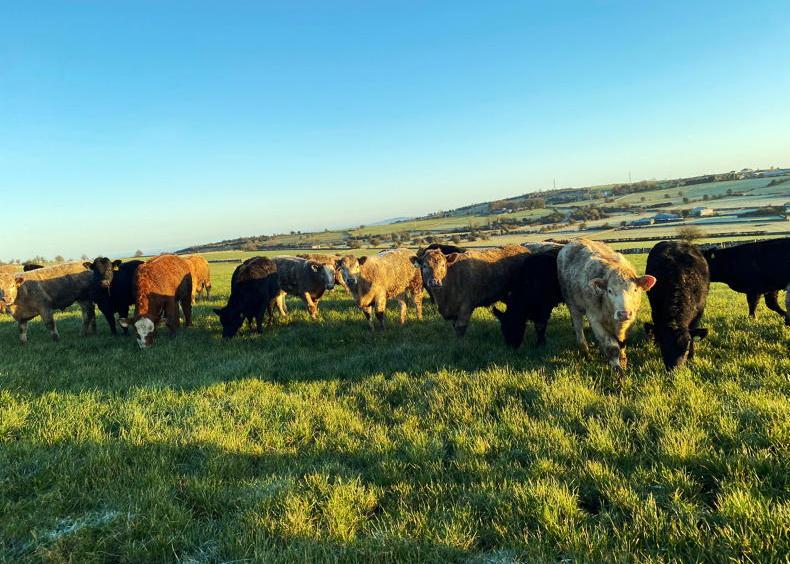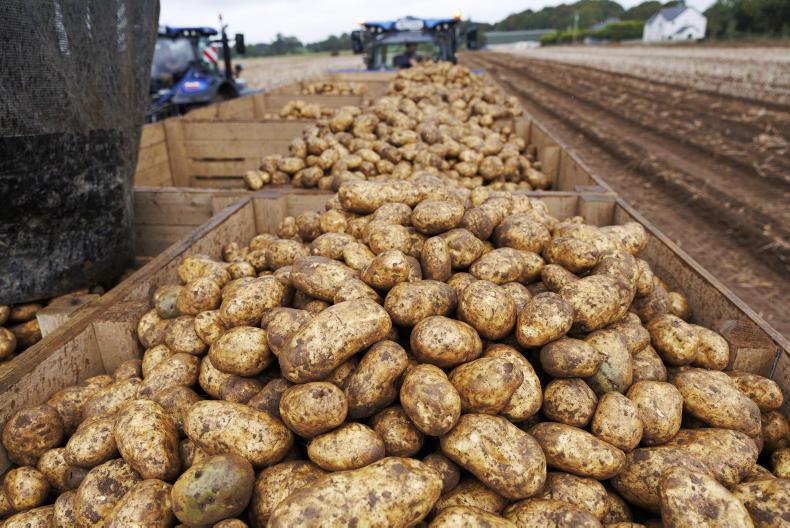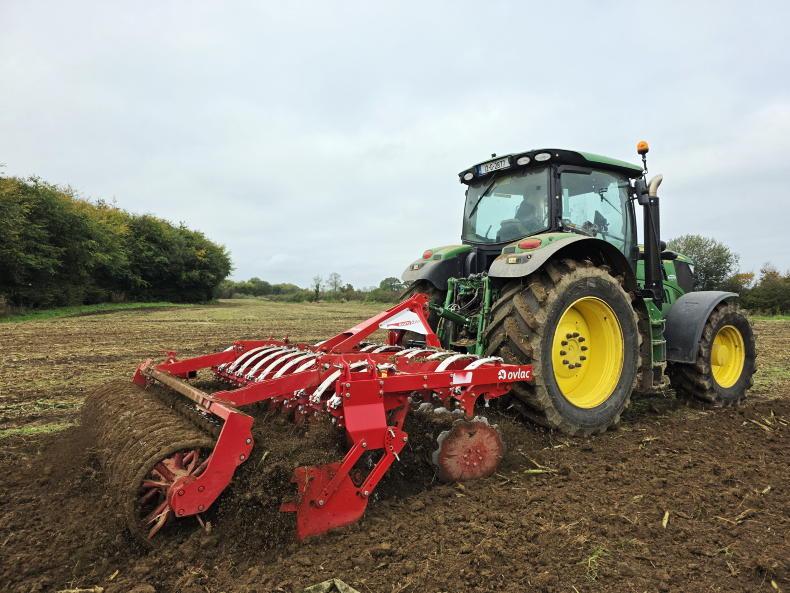For most farmers, the cost and lost output associated with fully reseeding paddocks with grass and clover is just too large for it to be done on a large scale across the farm.
Now, new on-farm research carried out by Teagasc has shown that over-sowing perennial ryegrass swards with white clover can be just as successful at getting clover established as a full reseed, and with far less of an impact on annual tonnage grown.
The data was compiled based on a subset of farms in the Clover150 project.
In 2022, over 90ha across the farms were fully reseeded and 91ha across the farms were over-sown with white clover. In October last year, the same year of sowing, the average clover content in both treatments was 15% – no difference. However, ensuring that the correct paddocks with optimal soil fertility are selected and paddocks are managed correctly post over-sowing are vital to ensure success.
Big difference
There was a big difference in total tonnage though, with the over-sown swards growing 13.26t DM/ha in 2022 compared to just 9.63t DM/ha in the fully reseeded paddocks.
More chemical nitrogen was applied in the over-sown paddocks at 166kg N/ha, on average, compared to 129kg N/ha for the fully reseeded paddocks.
According to Clover150 team member Caitlin Looney, the results highlight that over-sowing can be as successful as full reseeding, but it is vital that over-sowing is carried out in April, due to soil moisture, with a 3% higher sward clover content in April over-sown swards, compared to May or June.
The optimum sowing rate for over-sowing is 5kg to 6kg/ha (2kg to 2.5kg/acre).
In total, there is 1,629ha of land on the Clover150 programme farms. There was an inverse relationship between clover content, nitrogen use and pasture grown. This means that as clover content increased, farmers spread less chemical nitrogen and grew more grass.
This data is shown in Table 1, with the paddocks at the optimum clover range of 21% to 30% clover content growing 12.8t DM/ha from 130kg N/ha.
However, when farmers reduced chemical nitrogen when sward clover content was less than 15%, overall pasture production was reduced, highlighting that to reduce nitrogen, clover content must be above 20% to maintain pasture production.
Word from the industry is that both red and white clover seed will be scarce again this year.
While the advice has always been to purchase varieties that are on the Irish or UK recommended lists, this may not be possible due to scarcities of seed.
As usual, farmers looking for clover seed should contact their local merchant who can then purchase directly from the distributors mentioned below.
Pat Cashman from Goldcrop says they are prioritising their top white clover varieties such as Chieftain, Crusader and Barblanca for seed mixtures, which he says offer the best chance of success.
Goldcrop will be selling the white clover variety Liflex for bulk orders of clover seed on its own for oversowing.
Pat says this is a very common variety in Europe and worked well in Ireland last year. It is not on the Irish or UK recommended lists. In terms of red clover, Goldcrop will have increased supply of last year’s varieties: Spurt, Rozeta and Bonus. None of these are on the UK recommended lists.

In 2022, over 90ha across the farms were fully reseeded.
Fearga, an Irish-bred variety that is on the UK recommended list, will be available for the end of the season. Pat says that more new Irish-bred white clover varieties will be available from Goldcrop next year.
Market requirements
Paul Flanagan from DLF Seeds, based in Waterford, says they are one of the main importers of clover seed into Ireland, bringing in 50% to 60% of market requirements.
He says the company has brought in around 40% more white clover seed this year and that has already been distributed to seed suppliers. These are well-known varieties, Chieftan, Buddy, Iona and Coolfin.
He says that if there is a big demand for clover seed this year for oversowing, supplies in Ireland could be tight.
Paul says that UK recommended clover seed varieties are available in Europe at present, but he cannot guarantee that they will be available in the summer when the demand for seed in Ireland is known.
In relation to red clover, he says that this market has grown considerably in recent years but he reckons there will be enough supply available to meet farmer demand.
The varieties that DLF distributes are: Garant and Rozeta, which are both silage varieties. It will have limited supply of Sinope and Amos (both on the UK recommended lists). Pastour, which is a red clover variety suitable for grazing will be in limited supply also, Paul says.
Positive
Mary McEvoy from Germinal is also relatively positive on clover seed availability, despite the poor clover seed harvesting conditions experienced in New Zealand last year.
She says Germinal will have all recommended list varieties in its grass seed mixture for 2023 and a mix of both recommended list and non-recommended list varieties for those looking for oversowing with white clover.
The main recommended list varieties being handled by Germinal this year are AberSwan, Buddy and AberHerald.
Mary says a new hybrid clover variety called DoubleRoot is showing extraordinary persistence traits and is already playing a strong role in perennial cover crops in Europe.
In relation to red clover, Mary says that Germinal Ireland has good stock of Rozeta red clover, which has been used in Ireland for a number of years now and is suited for intensive silage.
She says the company is not expecting any supply issues with red clover and hopes to have good supply of AberClaret next season – which is on the UK recommended list.
For most farmers, the cost and lost output associated with fully reseeding paddocks with grass and clover is just too large for it to be done on a large scale across the farm.
Now, new on-farm research carried out by Teagasc has shown that over-sowing perennial ryegrass swards with white clover can be just as successful at getting clover established as a full reseed, and with far less of an impact on annual tonnage grown.
The data was compiled based on a subset of farms in the Clover150 project.
In 2022, over 90ha across the farms were fully reseeded and 91ha across the farms were over-sown with white clover. In October last year, the same year of sowing, the average clover content in both treatments was 15% – no difference. However, ensuring that the correct paddocks with optimal soil fertility are selected and paddocks are managed correctly post over-sowing are vital to ensure success.
Big difference
There was a big difference in total tonnage though, with the over-sown swards growing 13.26t DM/ha in 2022 compared to just 9.63t DM/ha in the fully reseeded paddocks.
More chemical nitrogen was applied in the over-sown paddocks at 166kg N/ha, on average, compared to 129kg N/ha for the fully reseeded paddocks.
According to Clover150 team member Caitlin Looney, the results highlight that over-sowing can be as successful as full reseeding, but it is vital that over-sowing is carried out in April, due to soil moisture, with a 3% higher sward clover content in April over-sown swards, compared to May or June.
The optimum sowing rate for over-sowing is 5kg to 6kg/ha (2kg to 2.5kg/acre).
In total, there is 1,629ha of land on the Clover150 programme farms. There was an inverse relationship between clover content, nitrogen use and pasture grown. This means that as clover content increased, farmers spread less chemical nitrogen and grew more grass.
This data is shown in Table 1, with the paddocks at the optimum clover range of 21% to 30% clover content growing 12.8t DM/ha from 130kg N/ha.
However, when farmers reduced chemical nitrogen when sward clover content was less than 15%, overall pasture production was reduced, highlighting that to reduce nitrogen, clover content must be above 20% to maintain pasture production.
Word from the industry is that both red and white clover seed will be scarce again this year.
While the advice has always been to purchase varieties that are on the Irish or UK recommended lists, this may not be possible due to scarcities of seed.
As usual, farmers looking for clover seed should contact their local merchant who can then purchase directly from the distributors mentioned below.
Pat Cashman from Goldcrop says they are prioritising their top white clover varieties such as Chieftain, Crusader and Barblanca for seed mixtures, which he says offer the best chance of success.
Goldcrop will be selling the white clover variety Liflex for bulk orders of clover seed on its own for oversowing.
Pat says this is a very common variety in Europe and worked well in Ireland last year. It is not on the Irish or UK recommended lists. In terms of red clover, Goldcrop will have increased supply of last year’s varieties: Spurt, Rozeta and Bonus. None of these are on the UK recommended lists.

In 2022, over 90ha across the farms were fully reseeded.
Fearga, an Irish-bred variety that is on the UK recommended list, will be available for the end of the season. Pat says that more new Irish-bred white clover varieties will be available from Goldcrop next year.
Market requirements
Paul Flanagan from DLF Seeds, based in Waterford, says they are one of the main importers of clover seed into Ireland, bringing in 50% to 60% of market requirements.
He says the company has brought in around 40% more white clover seed this year and that has already been distributed to seed suppliers. These are well-known varieties, Chieftan, Buddy, Iona and Coolfin.
He says that if there is a big demand for clover seed this year for oversowing, supplies in Ireland could be tight.
Paul says that UK recommended clover seed varieties are available in Europe at present, but he cannot guarantee that they will be available in the summer when the demand for seed in Ireland is known.
In relation to red clover, he says that this market has grown considerably in recent years but he reckons there will be enough supply available to meet farmer demand.
The varieties that DLF distributes are: Garant and Rozeta, which are both silage varieties. It will have limited supply of Sinope and Amos (both on the UK recommended lists). Pastour, which is a red clover variety suitable for grazing will be in limited supply also, Paul says.
Positive
Mary McEvoy from Germinal is also relatively positive on clover seed availability, despite the poor clover seed harvesting conditions experienced in New Zealand last year.
She says Germinal will have all recommended list varieties in its grass seed mixture for 2023 and a mix of both recommended list and non-recommended list varieties for those looking for oversowing with white clover.
The main recommended list varieties being handled by Germinal this year are AberSwan, Buddy and AberHerald.
Mary says a new hybrid clover variety called DoubleRoot is showing extraordinary persistence traits and is already playing a strong role in perennial cover crops in Europe.
In relation to red clover, Mary says that Germinal Ireland has good stock of Rozeta red clover, which has been used in Ireland for a number of years now and is suited for intensive silage.
She says the company is not expecting any supply issues with red clover and hopes to have good supply of AberClaret next season – which is on the UK recommended list.










SHARING OPTIONS